The NVIDIA GeForce GTX 980 Ti Review
by Ryan Smith on May 31, 2015 6:00 PM ESTCompute
Shifting gears, we have our look at compute performance. Since GTX Titan X has no compute feature advantage - no fast double precision support like what's found in the Kepler generation Titans - the performance difference between the GTX Titan X and GTX 980 Ti should be very straightforward.
Starting us off for our look at compute is LuxMark3.0, the latest version of the official benchmark of LuxRender 2.0. LuxRender’s GPU-accelerated rendering mode is an OpenCL based ray tracer that forms a part of the larger LuxRender suite. Ray tracing has become a stronghold for GPUs in recent years as ray tracing maps well to GPU pipelines, allowing artists to render scenes much more quickly than with CPUs alone.
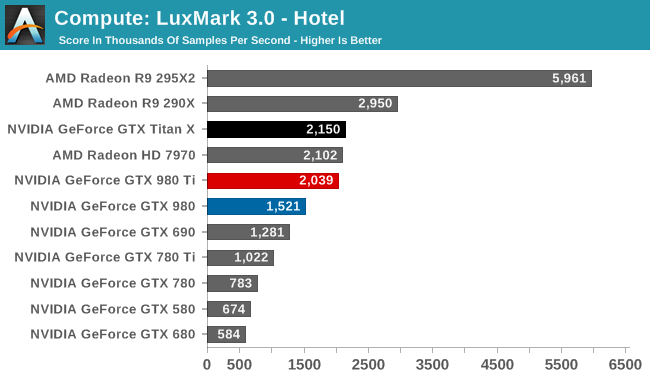
With the pace set for GM200 by GTX Titan X, there’s little to say here that hasn’t already been said. Maxwell does not fare well in LuxMark, and while GTX 980 Ti continues to stick very close to GTX Titan X, it none the less ends up right behind the Radeon HD 7970 in this benchmark.
For our second set of compute benchmarks we have CompuBench 1.5, the successor to CLBenchmark. CompuBench offers a wide array of different practical compute workloads, and we’ve decided to focus on face detection, optical flow modeling, and particle simulations.
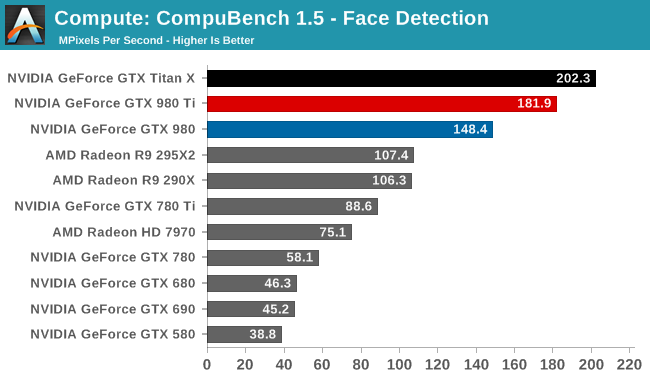
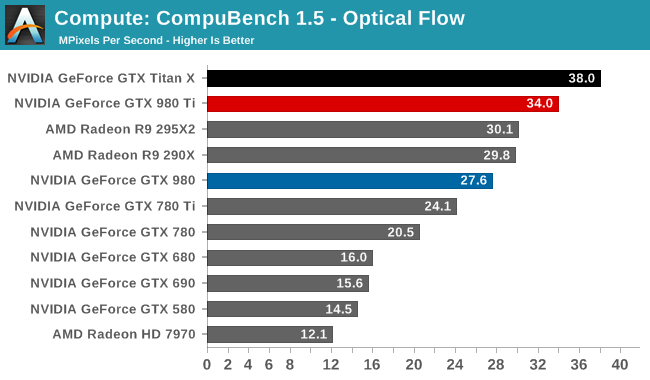
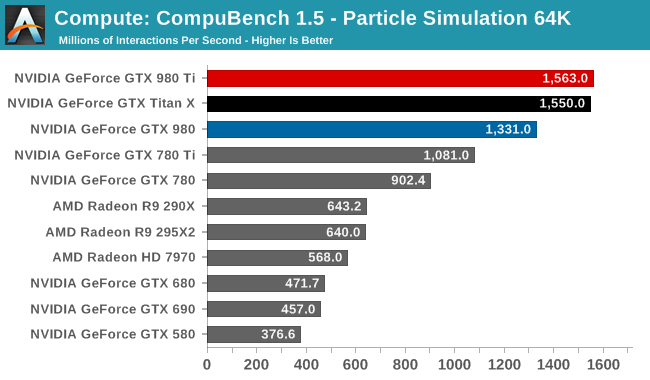
Although GTX T980 Ti struggled at LuxMark, the same cannot be said for CompuBench. Though taking the second spot in all 3 sub-tests - right behind GTX Titan X - there's a bit wider of a gap than normal between the two GM200 cards, causing GTX 980 Ti to trail a little more significantly than in other tests. Given the short nature of these tests, GTX 980 Ti doesn't get to enjoy its usual clockspeed advantage, making this one of the only benchmarks where the theoretical 9% performance difference between the cards becomes a reality.
Our 3rd compute benchmark is Sony Vegas Pro 13, an OpenGL and OpenCL video editing and authoring package. Vegas can use GPUs in a few different ways, the primary uses being to accelerate the video effects and compositing process itself, and in the video encoding step. With video encoding being increasingly offloaded to dedicated DSPs these days we’re focusing on the editing and compositing process, rendering to a low CPU overhead format (XDCAM EX). This specific test comes from Sony, and measures how long it takes to render a video.

Traditionally a benchmark that favors AMD, GTX 980 Ti fares as well as GTX Titan X, closing the gap some. But it's still not enough to surpass Radeon HD 7970, let alone Radeon R9 290X.
Moving on, our 4th compute benchmark is FAHBench, the official Folding @ Home benchmark. Folding @ Home is the popular Stanford-backed research and distributed computing initiative that has work distributed to millions of volunteer computers over the internet, each of which is responsible for a tiny slice of a protein folding simulation. FAHBench can test both single precision and double precision floating point performance, with single precision being the most useful metric for most consumer cards due to their low double precision performance. Each precision has two modes, explicit and implicit, the difference being whether water atoms are included in the simulation, which adds quite a bit of work and overhead. This is another OpenCL test, utilizing the OpenCL path for FAHCore 17.
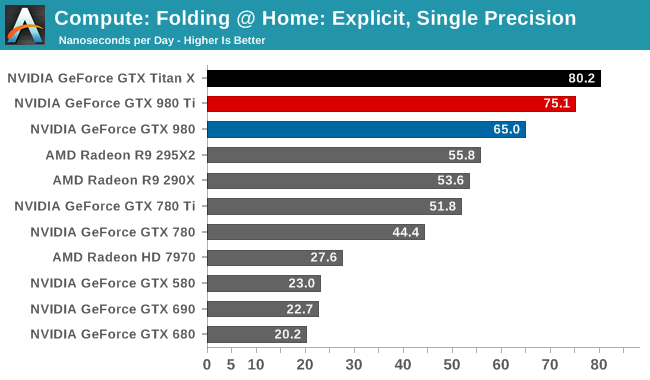
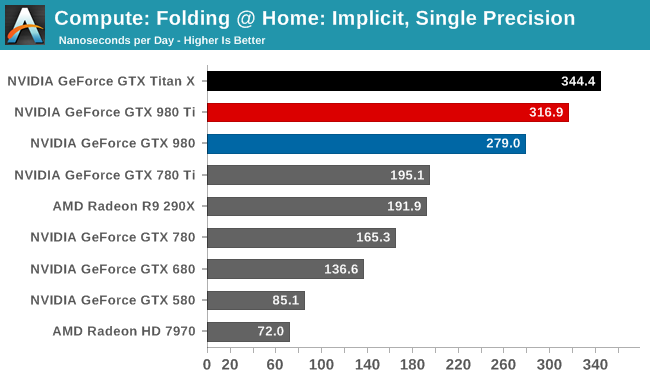
Folding @ Home’s single precision tests reiterate GM200's FP32 compute credentials. Second only to GTX Titan X, GTX 980 Ti fares very well here.
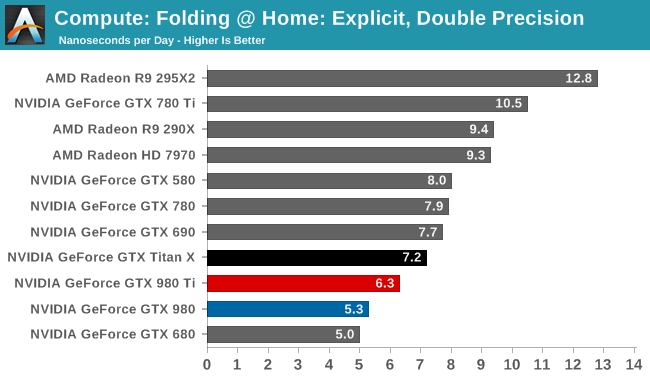
Meanwhile Folding @ Home’s double precision test reiterates GM200's poor FP64 compute performance. At 6.3ns/day, it, like the GTX Titan X, occupies the lower portion of our benchmark charts, below AMD's cards and NVIDIA's high-performnace FP64 cards.
Wrapping things up, our final compute benchmark is an in-house project developed by our very own Dr. Ian Cutress. SystemCompute is our first C++ AMP benchmark, utilizing Microsoft’s simple C++ extensions to allow the easy use of GPU computing in C++ programs. SystemCompute in turn is a collection of benchmarks for several different fundamental compute algorithms, with the final score represented in points. DirectCompute is the compute backend for C++ AMP on Windows, so this forms our other DirectCompute test.

We end up ending our benchmarks where we started: with the GTX 980 Ti slightly trailing the GTX Titan X, and with the two GM200 cards taking the top two spots overall. So as with GTX Titan X, GTX 980 Ti is a force to be reckoned with for FP32 compute, which for a pure consumer card should be a good match for consumer compute workloads.










290 Comments
View All Comments
mapesdhs - Wednesday, June 3, 2015 - link
He was highlighting incorrect grammar, not a typo. Btw, that should have been "it's", not "its", for the same reason. ;D My old English teacher would have used bullets for such errors if such as allowed...mapesdhs - Wednesday, June 3, 2015 - link
...and of course my own typo of 'as' instead of 'was' once again shows how annoying it is that in 2015 we still can't edit our posts on AT. :\FlushedBubblyJock - Wednesday, June 10, 2015 - link
thank you so much this is english class after allblastlike - Friday, June 26, 2015 - link
LOL you are so retarded. You try being a bitch and correcting others and at the end you fall into your own pit.Pathetic, lol keep it up.Gothmoth - Monday, June 1, 2015 - link
Toll, du beherrscht deine Mutterprache.. welch gewaltige Geistesleistung...... Amis.....Gothmoth - Monday, June 1, 2015 - link
2015 and on Anandtech we are still unable to edit comments.... here is the missing "s",freedom4556 - Friday, June 12, 2015 - link
...and you typo in yours? Or so Google translate suggests.shaolin95 - Friday, October 23, 2015 - link
Yes but the 980ti is still untouchable basically so 28nm or not...ComputerGuy2006...show me something better ;)Flunk - Sunday, May 31, 2015 - link
lower nm = more transistors in the same space = more performance, and possibly reductions in heat and power usage. There is only so much they can do on the 28nm node, which is why the next generation will likely utterly massacre the current one. 4K will be feasible at a reasonable price point.Refuge - Monday, June 1, 2015 - link
Depending on yields, lets not get too excited yet.I'll be excited when I get the email from Amazon saying my GTX1000TI is going to be here in two days and says I only spent $500 after rebate. :)